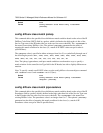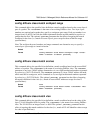
7000 Series L3 Managed Switch Reference Manual for Software v2.0
9-14 CLI Commands: Differentiated Services
Default none
Format config diffserv class match vlan <classname> <1-4094>
[exclude]
Policy Commands
The 'policy' command set is used in DiffServ to define:
Traffic Conditioning Specify traffic conditioning actions (policing, marking, shaping)
to apply to traffic classes
Service Provisioning Specify bandwidth and queue depth management requirements of
service levels (EF, AF, etc.)
The policy commands are used to associate a traffic class, which was defined by the class
command set, with one or more QoS policy attributes. This association is then assigned to an
interface in a particular direction to form a service. The user specifies the policy name when the
policy is created.
The DiffServ CLI does not necessarily require that users associate only one traffic class to one
policy. In fact, multiple traffic classes can be associated with a single policy, each defining a
particular treatment for packets that match the class definition. When a packet satisfies the
conditions of more than one class, preference is based on the order in which the classes were added
to the policy, with the foremost class taking highest precedence.
This set of commands consists of policy creation/deletion, class addition/removal, and individual
policy attributes. Note that the only way to remove an individual policy attribute from a class
instance within a policy is to remove the class instance and re-add it to the policy. The values
associated with an existing policy attribute can be changed without removing the class instance.
The CLI command root is
config diffserv policy.
config diffserv policy create
This command establishes a new DiffServ policy. The <policyname> parameter is a case-sensitive
alphanumeric string from 1 to 31 characters uniquely identifying the policy. The type of policy is
specific to either the inbound or outbound traffic direction as indicated by the
<in/out> parameter.


















